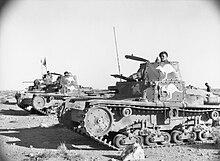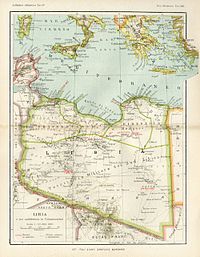
Fort Capuzzo was a fort in the colony of Italian Libya, near the Libya–Egypt border, next to the Italian Frontier Wire. The Litoranea Balbo ran south from Bardia to Fort Capuzzo, 8 mi (13 km) inland, west of Sollum, then east across the Egyptian frontier to the port over the coastal escarpment. The fort was built during the Italian colonial repression of Senussi resistance in the Second Italo-Senussi War (1923–1931), as part of a barrier on the Libya–Egypt and Libya–Sudan borders.

Operation Compass was the first large British military operation of the Western Desert Campaign (1940–1943) during the Second World War. British, Empire and Commonwealth forces attacked Italian forces of the 10th Army in western Egypt and Cyrenaica, the eastern province of Libya, from December 1940 to February 1941.

The 132nd Armored Division "Ariete" was an armored division of the Royal Italian Army during World War II. It was formed in 1939 as the second armored division after the 131st Armored Division "Centauro". The division fought in the Western Desert Campaign until being destroyed during the Second Battle of El Alamein and declared lost due to wartime events on 8 December 1942.
The 10th Army was a field army of the Royal Italian Army, which fought in World War I and in Italian North Africa during World War II.
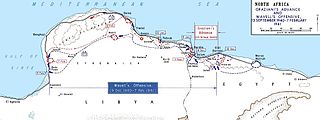
The Battle of Beda Fomm took place following the rapid British advance during Operation Compass. The Italian 10th Army was forced to evacuate Cyrenaica, the eastern province of Libya. In late January, the British learned that the Italians were retreating along the Litoranea Balbo from Benghazi. The 7th Armoured Division was dispatched to intercept the remnants of the 10th Army by moving through the desert, south of the Jebel Akhdar via Msus and Antelat as the 6th Australian Division pursued the Italians along the coast road, north of the jebel. The terrain was hard going for the British tanks and Combeforce, a flying column of wheeled vehicles, was sent ahead across the chord of the jebel.

The Frontier Wire was a 271 km (168 mi) obstacle in Italian Libya, along the length of the border of British-held Egypt, running from El Ramleh, in the Gulf of Sollum south to Jaghbub parallel to the 25th meridian east, the Libya–Egypt and Libya–Sudan borders. The frontier wire and its line of covering forts was built by the Italians during the Second Italo-Senussi War (1923–1931), as a defensive system to contain the Senussi population, who crossed from Egypt during their resistance against Italian colonisers.

The action at Mechili was an engagement between units of the British 7th Armoured Division of the Western Desert Force and Italian forces of the 10th Army during Operation Compass.

The Italian invasion of Egypt was an offensive in the Second World War, against British, Commonwealth and Free French in the neutral Kingdom of Egypt. The invasion by the Italian 10th Army ended border skirmishing on the frontier and began the Western Desert Campaign (1940–1943) proper. The Italian strategy was to advance from Libya along the Egyptian coast to seize the Suez Canal. After numerous delays, the scope of the offensive was reduced to an advance as far as Sidi Barrani and the engagement of any British forces in the area.

Pietro Maletti was an Italian General and war criminal who participated in World War I, the Italian colonization of Libya, the Second Italo-Abyssinian War, and World War II. He was killed in action during the early stages of the North Africa Campaign.

The Babini Group was an ad hoc armoured unit. The group was formed by the Italian Royal Army in Italian North Africa (Libya) at the start of the Western Desert Campaign of the Second World War. The group was formed in Libya, to be part of an armoured division assembled from tanks in the colony and from units sent from Italy. The new division was incomplete when the British began Operation Compass in December but the Babini Group fought in defence of the area between Mechili and Derna in late January.

133rd Armored Division "Littorio" was an armored division of the Royal Italian Army during World War II. The division's name derives from the fasces carried by the lictors of ancient Rome, which Benito Mussolini had adopted as symbol of state-power of the fascist regime. Sent to North Africa in January 1942 for the Western Desert Campaign the division was destroyed in the Second battle of El Alamein in November 1942.
The 2nd Libyan Division was an infantry division of the Royal Italian Army during World War II. In December 1940 the division formed, together with the 1st CC.NN. Division "23 Marzo" and 2nd CC.NN. Division "28 Ottobre", the XXIII Army Corps. The corps participated in the Italian invasion of Egypt and was destroyed during the Battle of Sidi Barrani.

The 63rd Infantry Division "Cirene" was an infantry division of the Royal Italian Army during World War II. The division was formed on 1 October 1937 in Benghazi in Italian Libya and named for the nearby antique city of Cyrene. The division's regimental depots were in mainland Italy in Liguria and shared with the 37th Infantry Division "Modena", with both divisions recruiting their troops from and training them there. The Cirene was classified as an auto-transportable division, meaning it had some motorized transport, but not enough to move the entire division at once. The division was destroyed on 5 January 1941 during the Battle of Bardia.

The 64th Infantry Division "Catanzaro" was an infantry division of the Royal Italian Army during World War II. The division was activated on 3 June 1940 and named for the Southern Italian city of Catanzaro. The division's regimental depots were in mainland Italy in Calabria and shared with other divisions recruiting in the region. The division was classified as an auto-transportable division, meaning it had some motorized transport, but not enough to move the entire division at once. The division took part in the Italian invasion of Egypt and was destroyed on 5 January 1941 during the Battle of Bardia.
The 1st Libyan Division was an infantry division of the Royal Italian Army during World War II. It was commanded by general Luigi Sibille. The division took part in the Italian invasion of Egypt and was destroyed during the Battle of Sidi Barrani.

The Battle of Sidi Barrani(10–11 December 1940) was the opening battle of Operation Compass, the first big British attack of the Western Desert Campaign of the Second World War. Sidi Barrani, on the Mediterranean coast in Egypt, had been occupied by the Italian 10th Army, during the Italian invasion of Egypt (9–16 September 1940) and was attacked by British, Commonwealth and imperial troops, who re-captured the port.

The Attack on Nibeiwa took place on 9 December 1940 near Nibeiwa, Egypt, when the Italian fortified camp held by the Maletti Group, the armoured force of the 10th Army, was overrun by British and Indian troops. The attack was the opening engagement of Operation Compass, a British raid which, if successful, would be followed up to try to expel the Italians from Egypt. Italy had declared war on France and Britain on 10 June and in the Italian invasion of Egypt from 9 to 16 September 1940, the Italian 10th Army had reached the port of Sidi Barrani and dug in to await the completion of the Via della Vittoria, an extension of the Via Balbia, being built from the frontier. The Maletti Group garrisoned a camp at Nibeiwa,12 mi (19 km) south of the port of Sidi Barrani.
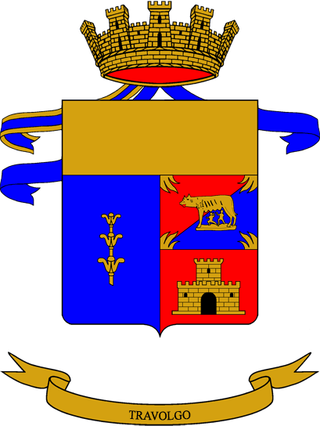
The 4th Tank Regiment is a tank regiment of the Italian Army based in Persano in Campania. The regiment is equipped with Ariete main battle tanks and assigned to the Bersaglieri Brigade "Garibaldi". The regiment was formed in 1936 as a training and administrative formation. During World War II the regimental command was sent to Libya, where it fought in the Western Desert campaign. The regimental command, and the battalions assigned to it, were destroyed during the British Operation Compass. For its conduct in North Africa the regiment was awarded Italy's highest military honor the Gold Medal of Military Valor. In March 1941, the regiment was reformed, but it remained in Rome for the rest of the war as a training command. The regiment was disbanded by German forces after the Armistice of Cassibile was announced on 8 September 1943.
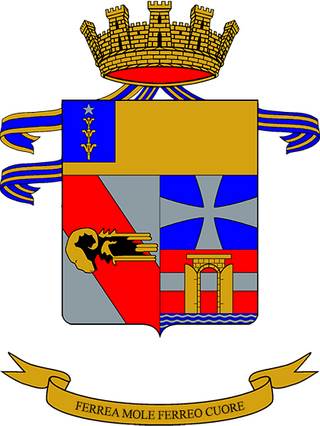
The 32nd Tank Regiment is a tank regiment of the Italian Army based in Tauriano in Friuli-Venezia Giulia. Originally the regiment, like all Italian tank units, was part of the infantry, but since 1 June 1999 it is part of the cavalry. Operationally the regiment is assigned to the 132nd Armored Brigade "Ariete".

The British capture of Tobruk was a battle fought between 21 and 22 January 1941, as part of Operation Compass, the first offensive of the Western Desert Force (WDF) in the Western Desert Campaign of the Second World War. After defeating the Italians in the Battle of Bardia, the 6th Australian Division and the 7th Armoured Division pressed on and made contact with the Italian garrison in Tobruk on 6 January.


